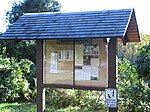Kreeger Museum
1994 establishments in Washington, D.C.Art museums and galleries in Washington, D.C.Art museums established in 1994Former private collections in the United StatesHouses completed in 1967 ... and 1 more
Philip Johnson buildings

The Kreeger Museum is a modern and contemporary non-profit art museum located in Washington D.C. It is located in the former home of David Lloyd Kreeger and Carmen Kreeger and it contains the art collection they acquired from 1952 to 1988.
Excerpt from the Wikipedia article Kreeger Museum (License: CC BY-SA 3.0, Authors, Images).Kreeger Museum
Foxhall Road Northwest, Washington
Geographical coordinates (GPS) Address Website External links Nearby Places Show on map
Geographical coordinates (GPS)
| Latitude | Longitude |
|---|---|
| N 38.921813888889 ° | E -77.089116666667 ° |
Address
Kreeger Museum
Foxhall Road Northwest 2401
20007 Washington
District of Columbia, United States
Open on Google Maps








